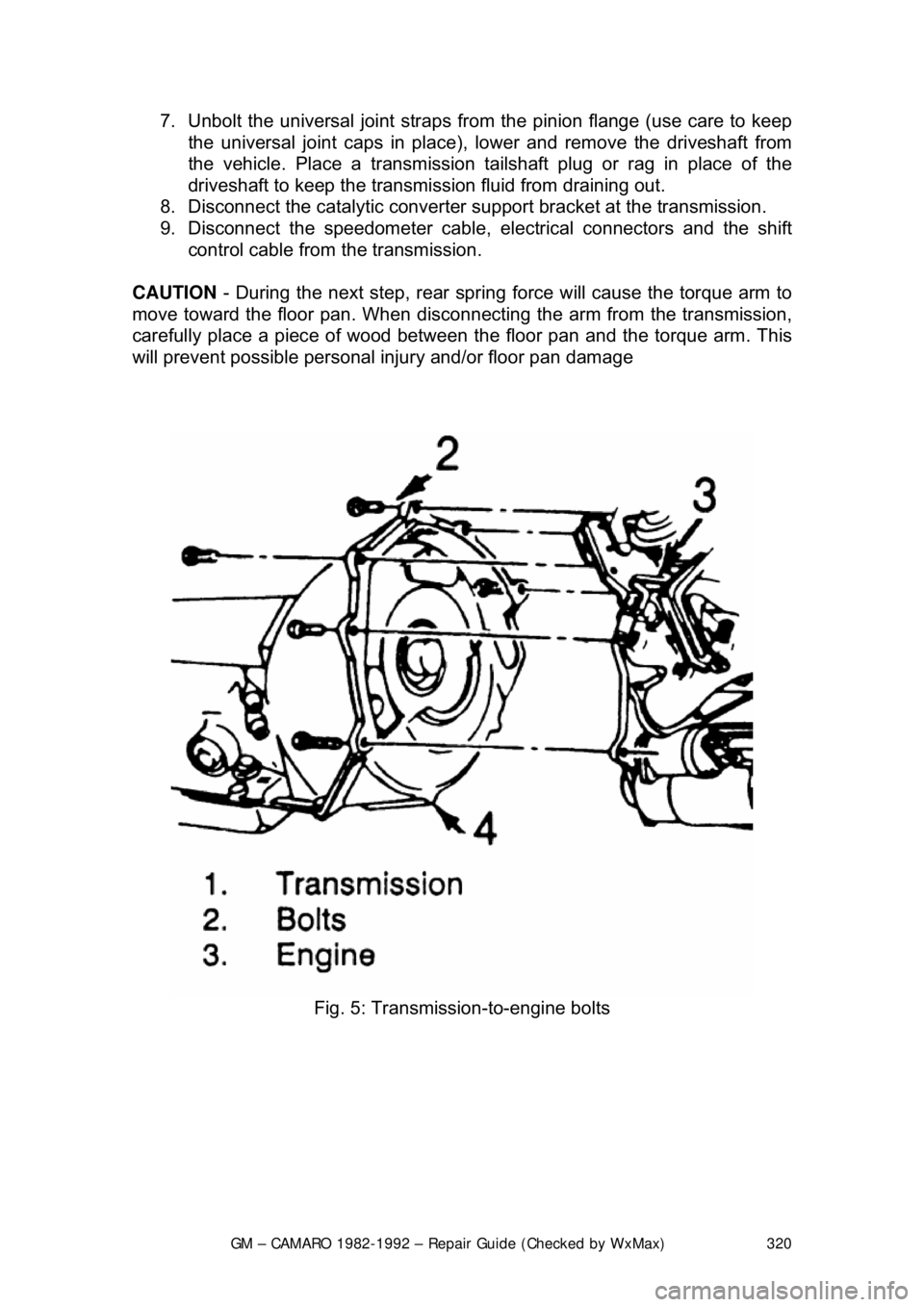1982 CHEVROLET CAMARO catalytic converter
[x] Cancel search: catalytic converterPage 320 of 875

GM – CAMARO 1982-1992 – Repair Guide (Checked by WxMax) 320
7. Unbolt the universal joint straps fr
om the pinion flange (use care to keep
the universal joint caps in place), lower and remove the driveshaft from
the vehicle. Place a transmission tailshaft plug or rag in place of the \
driveshaft to keep the transmission fluid from draining out.
8. Disconnect the catalytic converter support bracket at the transmission.
9. Disconnect the speedometer cable, electrical connectors and the shift
control cable from the transmission.
CAUTION - During the next step, rear spring force will cause the torque arm to
move toward the floor pan. When disconn ecting the arm from the transmission,
carefully place a piece of wood between the floor pan and the torque arm. This
will prevent possible personal injury and/or floor pan damage
Fig. 5: Transmission-to-engine bolts
Page 322 of 875

GM – CAMARO 1982-1992 – Repair Guide (Checked by WxMax) 322
CAUTION - The transmission must be secu red to the transmission jack
17. Remove the transmission from the vehicle. Be careful not to damage the oil cooler lines, throttle valve cable, or the shift control cable. Also, keep
the rear of the transmissi on lower than the front to avoid the possibility of
the torque converter disengagi ng from the transmission.
To install: 18. Position the transmission and converter into place.
19. Install the transmission -to-engine mounting bolts.
20. Connect the throttle valve cable and oil cooler lines to the transmissio\
n.
21. Install the transmission cro ssmember and secure with bolts.
22. Install the transmission mount bolt.
23. Matchmark the torque converter-to-f lywheel. Install the torque converter-
to-flywheel attaching bolts.
Before installing the converter-to-flywheel bolts, be sure that the weld nuts on
the converter are flush with the flywheel, and that the converter rotates freely by
hand in this position.
24. Install the flywheel cover.
25. Install the torque arm-to-transmission bolts.
26. Connect the speedometer cable, el ectrical connectors and the shift
control cable from the transmission.
27. Connect the catalytic converter s upport bracket at the transmission.
28. Align the matchmark m ade earlier, then install the driveshaft to the axle
pinion. Bolt the universal joint straps to the pinion flange.
29. Lower the vehicle.
30. Install the dipstick tube using a ne w dipstick tube O-ring and secure with
the bolt. Install the tran smission oil dipstick.
31. Connect the throttle valve (TV) c ontrol cable at the carburetor.
32. Install the air cleaner assembly.
33. Connect the negative battery cable at the battery.
DRIVELINE
DRIVESHAFT AND U-JOINTS
The U-joint is secured to the yoke in one of two ways. Dana and Cleveland
shafts use a conventional snapring to ho ld each bearing cup in the yoke. The
snapring fits into a groove located in eac h yoke end just on top of each bearing
cup. The Saginaw design shaft secures its U-joints in another way. Nylon
material is injected through a small hole in the yoke and flows along a circular
groove between the U-joint and the yoke , creating a synthetic snapring.
Disassembly of the Saginaw U-joint requi res the joint to be pressed from the
yoke. This results in damage to the be aring cups and destruction of the nylon
rings.
Page 422 of 875

GM – CAMARO 1982-1992 – Repair Guide (Checked by WxMax) 422
4. Drain the engine oil.
CAUTION
- Be sure that the catalytic c onverter is cool before proceeding.
5. Remove the air injection pipe at t he catalytic converter, if applicable.
6. Remove the catalytic converte r hanger bolts. Disconnect the exhaust
pipe at the manifold.
7. Remove the starter bolts, loosen t he starter brace, then lay the starter
aside.
8. Remove the front engine mount through-bolts.
9. Raise the engine enough to provide sufficient clearance for oil pan
removal.
10. Remove the oil pan bolts.
If the front crankshaft throw prohibits remo val of the pan, turn the crankshaft to
position the throw horizontally.
11. Remove the oil pan from the vehicle.
12. Remove the old RTV sealant or gasket from the oil pan and engine
block.
To install: 13. Run a
1/8 in. (3mm) bead of RTV around the oil pan sealing surface or
install a new gasket. Remember to keep the RTV on the INSIDE of the
bolt holes.
14. Install the pan and pan bolts. Torque the pan bolts to:
• 2.8L & 3.1L V6 (M6 x 1 X 16.0 bolts): 6-9 ft. lbs. (8-12 Nm)
• 2.8L & 3.1L V6 (M8 x 1.25 x 14.0 bolts ): 15-22 ft. lbs. (20-30 Nm)
• 1982-84 V8 engine (5/16-18 bolts): 165 inch lbs. (10 Nm)
• 1982-84 V8 engine (1/4-20 bolts): 80 inch lbs. (8 Nm)
• 1985 V8 engine (5/16-18 x 1.44 studs): minimum of 10 inch lbs.
• 1985 V8 engine (stud nuts): 150- 180 inch lbs. (17-20 Nm)
• 1985 V8 engine (1/4-20 x 0.56 bolts): 72-90 inch lbs. (8-10 Nm)
• 1985 V8 engine (1/4-20 x 0.50 x 0.56 studs): 72-90 inch lbs. (8-10
Nm)
• 1986-92 V8 engine (stud nuts): 150-250 inch lbs. (17-28 Nm)
• 1986-92 V8 engine (1/4-20 x 0.56 bolts): 72-130 inch lbs. (8-14
Nm)
• 1986-92 V8 engine (1/4-20 x 0.50 x 0.56 studs ): 72-130 inch lbs.
(8-14 Nm)
15. Lower the engine and install t he front engine mount through-bolts.
Torque bolts to 48 ft. lbs. (65 Nm).
16. Install the starter and starter brace, then secure using starter bolts.
17. Connect the exhaust pipe at the manifo ld. Install the catalytic converter
hanger bolts.
18. Install the air injection pipe at the catalytic converter.
19. Lower the vehicle.
20. Install the fan shroud assembly . Install the distributor cap.
21. Connect the negative battery cable at the battery and air cleaner.
Page 562 of 875

GM – CAMARO 1982-1992 – Repair Guide (Checked by WxMax) 562
Air is injected into either the exhaust
port(s), the exhaust manifold(s) or the
catalytic converter by an engine driven ai r pump. The system is in operation at
all times and will bypass air only mom entarily during deceleration and at high
speeds. The bypass function is performed by the air control valve, while the
check valve protects the air pump by pr eventing any backflow of exhaust gases.
The AIR system helps r educe HC and CO content in the exhaust gases by
injecting air into the exhaust ports dur ing cold engine operation. This air
injection also helps the catalytic conv erter to reach the proper temperature
quicker during warmup. When the engine is warm (Closed Loop), the AIR
system injects air into the beds of a th ree-way converter to lower the HC and
the CO content in the exhaust.
The system utilizes the following components:
1. An engine driven AIR pump.
2. AIR Control valves (Air Control, Air Switching).
3. Air flow and control hoses.
4. Check valves.
5. A dual-bed, three-way catalytic converter.
6. A deceleration back-fire control valve - 2.8L engine only.
The belt driven, vane-type air pump is lo cated at the front of the engine and
supplies clean air to the AIR system fo r purposes already stated. When the
engine is cold, the Electronic Control Module (ECM) energizes an AIR control
solenoid. This allows air to flow to the AIR switching valve. The AIR switching
valve is then energized to direct air to the exhaust ports.
When the engine is warm, the ECM de-energ izes the AIR switching valve, thus
directing the air between the beds of the catalytic converter. This provides
additional oxygen for the ox idizing catalyst in the second bed to decrease HC
and CO, while at the same time keeping oxygen levels low in the first bed,
enabling the reducing catalyst to effect ively decrease the levels of NOx.
If the AIR control valve detects a r apid increase in manifold vacuum
(deceleration), certain operat ing modes (wide open throttle, etc.) or if the ECM
self-diagnostic system detects any problem in the system, air is diverted to the
air cleaner or directly into the atmosphere.
The primary purpose of the EC M's divert mode is to prevent backfiring. Throttle
closure at the beginning of deceleration will temporarily create air/fuel mixtures
which are too rich to burn completely . These mixtures become burnable when
they reach the exhaust if combined with the injection ai r. The next firing of the
engine will ignite this mixt ure causing an exhaust backf ire. Momentary diverting
of the injection air from the exhaust prevents this.
The AIR system check valves and hoses should be checked periodically for any
leaks, cracks or deterioration.